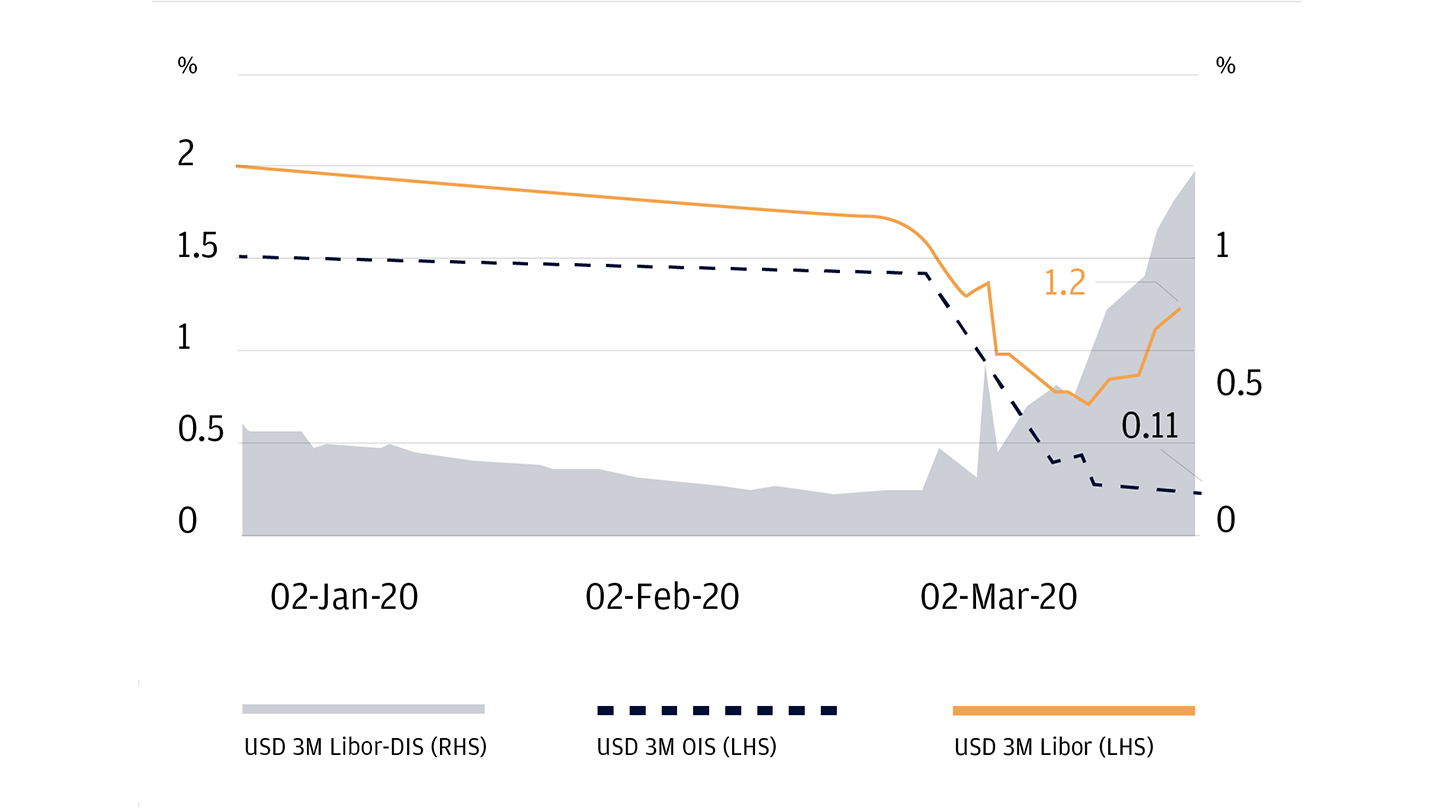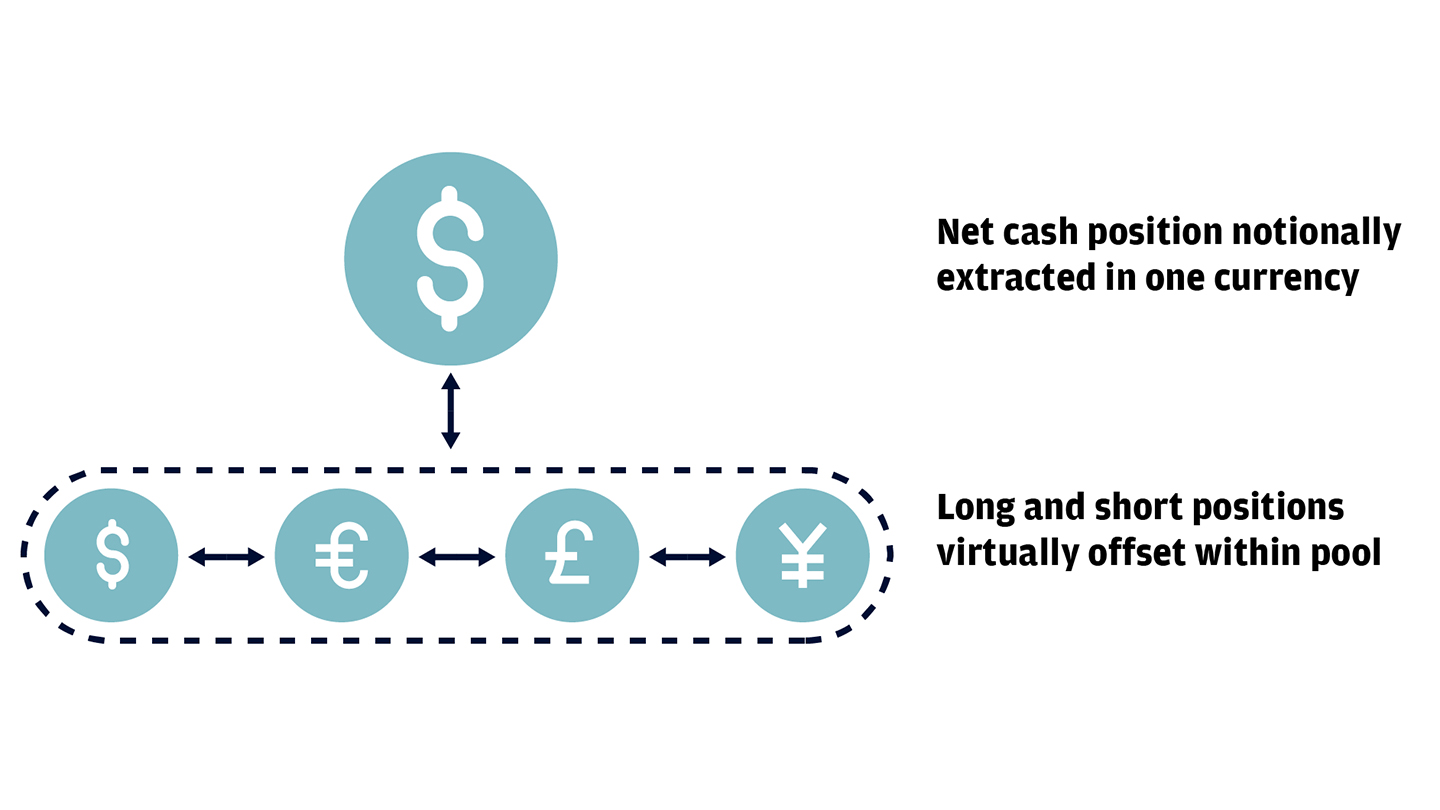
Companies with global operations are currently facing unprecedented conditions, operating against a backdrop of a worldwide pandemic and market turmoil. Unlike past financial disruption, COVID-19 is presenting a unique set of challenges not faced in recent memory.
Past weeks have raised significant disruption for companies, with supply chains interrupted or halted completely, workforces confined to working from home, and significant changes in supply/demand. In parallel, we have witnessed volatility in the financial markets prompting the central banks to respond with various measures including monetary policy easing.
What does this mean for companies, especially those with a global presence?
This article explores some of the key liquidity challenges on the horizon, how companies can leverage the benefits of cash management centralization through multicurrency pooling and other innovations.
Multicurrency notional pooling
Multicurrency notional pooling is a liquidity management technique that:
- Enables corporations to virtually offset long and short positions across their multiple currency accounts, potentially reducing operating costs.
- Centralizes liquidity across multiple currencies.
- Reduces the need for effecting physical currency conversions to cover funding shortfalls.
- Diminishes the need to execute frequent FX swaps.
- May be used to notionally extract the net cash position across multiple currencies in a single currency.
Releasing idle liquidity
Scenario: Treasury function is distributed globally, with de-centralized cash positions.
In times of market stress, raising short term working capital can become more costly to companies seeking short term liquidity. As seen in prior years, when demand for liquidity outpaces availability the cost of short term borrowing can rise significantly in a short period of time. The chart below shows the increased cost of borrowing in the recent volatile markets.
USD 3M Libor vs 3M overnight rates – Q1 2020

Idle cash is a considerable opportunity cost to a company. Identifying and extracting idle liquidity is a key step towards reducing reliance on potentially expensive working capital funding costs.
Corporate treasury functions can benefit from accessing and centralizing liquidity across regions and currencies using a “follow-the-sun” liquidity structure via multi-currency notional pool in regions that can seamlessly connect need of funds to source of funds.
Managing current asset-liability mismatch
Scenario: Sales cycle disruption is creating an imbalance in accounts payable and receivable across geographies and currencies.
The first quarter of 2020 saw widespread measures to combat the spread of COVID-19 such as border closures and changes to manufacturing has had a widespread impact on worldwide supply chains.
Global companies with diverse geographic operations and customer base now face funding mismatches in payables and receivables across different currencies adding to the challenges in maintaining working capital efficiency. Such organisations can leverage the inherent notional offset features of a multi-currency notional pool, utilized group liquidity across currencies and reduce operating costs.
- Both long and short balances held across entities and currencies can be virtually set off.
- For example, in a multi-entity multi-currency notional pool, a parent entity holds +$5mm and the subsidiary entity holds -€2mm.
- The net is an overall long position at prevalent FX rates, which can be notionally extracted from the pool, providing additional liquidity that may otherwise be inaccessible.

Visibility and automating workflows
Scenario: Existing treasury management is dependent on manual reconciliation and cash concentration at end of day, with currency positions managed independently.
Traditional treasury functions may have a heavy reliance on manual tasks completed by employees located in company office locations. As made apparent recently, business resiliency measures such as working from home pose operational challenges.
A key enabler of effective liquidity management is near real-time visibility across all accounts, regions within a given structure via a single unified global platform. Supplementing visibility, a flexible cash management structure provides access to funds and can aid companies in managing periods of irregular activity. Such an infrastructure with the right banking partner aids optimum corporate decisions.
Virtual account management
- Virtual Account Management (VAM) integrated with notional pooling accounts presents a significant opportunity to remove manual operations by enabling native cash pooling.
- Using VAM to apply sub-ledgers to physical bank accounts achieves segregated reporting to match the internal corporate structures, separating out treasury, account payable/receivable and payroll activities via Virtual Accounts in each currency.
- Alignment of sub-ledgers to organizational structure can ease reconciliation challenges, enabling automation and granularity of reporting reducing the operational burden on the work force.
Cashflow timing considerations
Scenario: Active risk management of expense and revenues in non-functional currencies in line with internal currency management policies
A company with advanced treasury management policies might have hedged future cash flows in non-functional currencies. With the possible disruptions mentioned before in payables and receivables this company might experience timing mismatches in realizing the sales proceeds/cost vis-a-vis hedge maturity. This situation could potentially increase the operating costs (over draft in currencies), costs of hedging (altering terms of the hedge).
In a notional pool, a short position can occur in supported pooling currencies to meet payment/hedging obligations. Assuming sufficient long positions in other currencies within the pool, the structure would remain in an overall neutral or long position. The individual short positions within the pooling structure will not incur the overdraft charges there by reducing operational costs and optimising working capital efficiency whilst simultaneously enabling internal treasury policies.
In these uncertain times, we thank you again for your continued trust in J.P. Morgan. Please contact your J.P. Morgan representative for further information.
Harnessing the power of digital to manage disruption
It is becoming increasingly clear that digital transformation, broadly defined, will increasingly rise on the corporate and treasury agenda. In our recent COVID-19 client webinar, 64% of participants chose “increased focus on digital” as a key takeaway from the unfolding crisis.
Rather than an aspirational statement of intent, we are seeing this priority backed up by concrete actions taken by clients. Here we summarize key learnings from the ongoing crisis and showcase a number of case studies wherein clients have partnered with J.P. Morgan to surmount challenges and unlock opportunities.
How treasury and payments can lead in a dynamic environment
Listen to our webcast replays:
Maintaining continuity with treasury operations in turbulent times
How has the triggering of business contingency plans impacted treasury, business and operations as staff shift to back-up or remote locations?
Harnessing the power of digital to manage uncertainty
What are the strategic challenges triggered by COVID-19 and what are the implications for treasury? Hear real-life case studies about how you can deploy digital capabilities to turn crisis into further opportunity.
Staying focused on cybersecurity and fraud prevention
What are the immediate risks around cybersecurity and fraud? What are the best practices to safeguard treasury and payments flows?
Optimising working capital for today’s challenges
What are the working capital pressures in the current environment? What are the best practices to consider in payables, receivables and inventory management and financing?
Registration is required for all webcasts.
Disclaimer
This material was prepared exclusively for the benefit and internal use of the JPMorgan client to whom it is directly addressed (including such client’s subsidiaries, the “Company”) in order to assist the Company in evaluating a possible transaction(s) and does not carry any right of disclosure to any other party. This material is for discussion purposes only and is incomplete without reference to the other briefings provided by JPMorgan. Neither this material nor any of its contents may be disclosed or used for any other purpose without the prior written consent of JPMorgan.
J.P. Morgan, JPMorgan, JPMorgan Chase and Chase are marketing names for certain businesses of JPMorgan Chase & Co. and its subsidiaries worldwide (collectively, “JPMC”). Products or services may be marketed and/or provided by commercial banks such as JPMorgan Chase Bank, N.A., securities or other non-banking affiliates or other JPMC entities. JPMC contact persons may be employees or officers of any of the foregoing entities and the terms “J.P. Morgan”, “JPMorgan”, “JPMorgan Chase” and “Chase” if and as used herein include as applicable all such employees or officers and/or entities irrespective of marketing name(s) used. Nothing in this material is a solicitation by JPMC of any product or service which would be unlawful under applicable laws or regulations.
Investments or strategies discussed herein may not be suitable for all investors. Neither JPMorgan nor any of its directors, officers, employees or agents shall incur in any responsibility or liability whatsoever to the Company or any other party with respect to the contents of any matters referred herein, or discussed as a result of, this material. This material is not intended to provide, and should not be relied on for, accounting, legal or tax advice or investment recommendations. Please consult your own tax, legal, accounting or investment advisor concerning such matters.
Not all products and services are available in all geographic areas. Eligibility for particular products and services is subject to final determination by JPMC and or its affiliates/subsidiaries. This material does not constitute a commitment by any JPMC entity to extend or arrange credit or to provide any other products or services and JPMorgan reserves the right to withdraw at any time. All services are subject to applicable laws, regulations, and applicable approvals and notifications. The Company should examine the specific restrictions and limitations under the laws of its own jurisdiction that may be applicable to the Company due to its nature or to the products and services referred herein.
Notwithstanding anything to the contrary, the statements in this material are not intended to be legally binding. Any products, services, terms or other matters described herein (other than in respect of confidentiality) are subject to the terms of separate legally binding documentation and/or are subject to change without notice.
JPMorgan Chase Bank, N.A. Member FDIC.
JPMorgan Chase Bank, N.A., organized under the laws of U.S.A. with limited liability.







